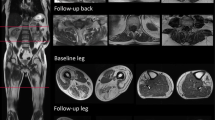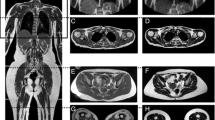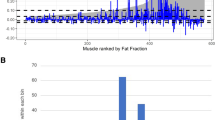Abstract
Using MRI, we evaluated the degree of involvement of muscles in the lower extremities of 18 unselected patients with facioscapulohumeral muscular dystrophy (FSHD). Findings were correlated with fragment size of the mutated gene, age, disease duration and muscle power.
Most affected muscles were the hamstrings followed by the tibialis anterior and the medial gastrocnemius. The vastus-, gluteal- and peroneal muscles were the most unaffected, and the psoas muscle did not show evidence of involvement in any of the investigated subjects. Asymmetric involvement was evident in 15% of the investigated muscles on MRI and 6% on manual muscle strength testing. MRI findings in muscle tended to correlate with disease duration (r = 0.49; p < 0.05), but not with gene fragment size or age. MRI disclosed involvement of muscles performing hip flexion and ankle dorsal flexion that could not be detected by manual muscle strength testing. Otherwise, there was a close correlation (≈ r = 0.75; p < 0.0001) between muscle strength and MRI severity score for other muscle groups.
The present study shows that MRI may disclose muscle involvement in FSHD that is not apparent on manual muscle testing, and suggests that MRI of muscle may be an important assessment tool in clinical trials involving patients with FSHD.

Similar content being viewed by others
References
Kilmer DD, Abresch RT, McCrory MA, Carter GT, Fowler WM Jr, Johnson ER, McDonald CM (1995) Profiles of neuromuscular diseases. Facioscapulohumeral muscular dystrophy. Am J Phys Med Rehabil. 74(5 Suppl):S131–139
Kissel JT (1999) Fascioscapulohumeral dystrophy. Semin Neurol 19:35–43
Kreigbaum E, barthels KM. Biomechanics. A qualitative approach for studying human movement. 4th edn. Allyn and Bacon 1996:pp 595–601
Lamminen AE (1990) Magnetic resonance imaging of primary skeletal muscle diseases: patterns of distribution and severity of involvement. Br J Radiol 63:946–950
Lunt PW, Jardine PE, Koch MC, Maynard J, Osborn M, Williams M, Harper PS, Upadhyaya M (1995) Correlation between fragment size at D4F10S1 and age at onset or at wheelchair use, with a possible generational effect, accounts for much phenotypic variation in 4q35-fascioscapulohumeral muscular dystrophy (FSHDD). Hum Mol Genet 4:951–958
Medical Research Council. Aids to the investigation of peripheral nerve injuries. London: Her Majesty’s Stationary Office 1976
Olsen DB, Ørngreen MC, Vissing J (2005) Aerobic training improves exercise performance in facioscapulohumeral muscular dystrophy. Neurology 64:1064–1066
Ozsarlak O, Schepens E, Parizel PM, Van Goethem JW, Vanhoenacker F, De Schepper AM, Martin JJ (2001) Hereditary neuromuscular diseases. EurJ Radiol 40:184–197
Phoeni J, Betal D, Roberts N, Helliwell TR, Edwards RHT (1996) Objective quantification of muscle and fat in human dystrophic muscle by magnetic resonance image analysis. Muscle Nerve 19:302–310
Ricci E, Galluzzi G, Deidda G, Cacurri S, Colantoni L, Merico B, Piazzo N, Servidei S, Vigneti E, Pasceri V, Silvestri G, Mirabella M, Mangiola F, Tonali P, Felicetti L (1999) Progress in the molecular diagnosis of facioscapulohumeral muscular dystrophy and correlation between the number of KpnI repeats at the 4q35 locus and clinical phenotype. Ann Neurol 45:751–757
Tawil R, Figlewicz DA, Griggs RC, Weiffenbach B (1998) Fascioscapulohumeral Dystrophy: A distinct regional myopathy with a novel molecular pathogenesis. Ann Neurol 43:279–282
Tawil R, Griggs RC. In: Karpati G, Hilton-Jones D, Griggs RC, (eds) Disorders of voluntary muscle; 7th edn. Cambridge University Press, 2001:464–470
Upadhyaya M, Cooper DN (2002) Molecular diagnosis of facioscapulohumeral muscular dystrophy. E pert Rev Mol Diagn 2:160–171
Wijmenga C, Frants RR, Brouwer OF, Moerer P, Weber JL, Padberg GW (1990) Location of the fascioscapulohumeral muscular dystrophy gene on chromosome 4. Lancet 336:651–653
Author information
Authors and Affiliations
Corresponding author
Additional information
Received in revised form: 10 March 2006
Rights and permissions
About this article
Cite this article
Olsen, D.B., Gideon, P., Jeppesen, T.D. et al. Leg muscle involvement in facioscapulohumeral muscular dystrophy assessed by MRI. J Neurol 253, 1437–1441 (2006). https://doi.org/10.1007/s00415-006-0230-z
Received:
Accepted:
Published:
Issue Date:
DOI: https://doi.org/10.1007/s00415-006-0230-z




